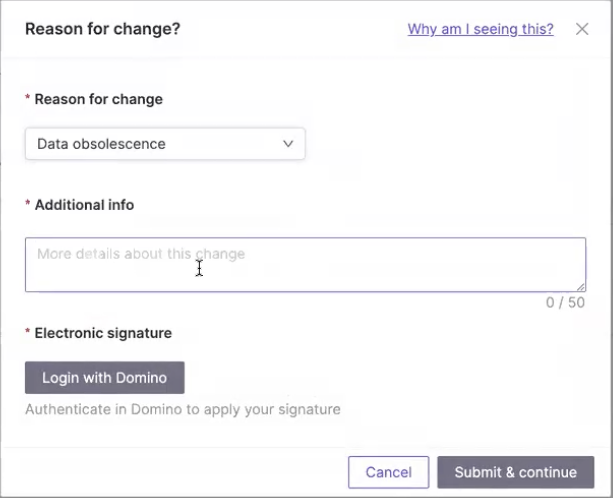Admins can require an e-signature by enabling the configuration record com.cerebro.domino.eSignatureWorkflowEnabled. E-signatures can be viewed in the Unified Audit Trail.
When enabled, critical actions trigger an RFC modal:
-
User provides a reason for change (select from dropdown or enter additional context).
-
User re-authenticates (password or SSO).
-
Action is submitted, and details are logged in the audit trail with:
-
Action performed
-
Reason for change
-
Electronic signature and timestamp
-

If Global or PerProject is enabled, the following actions will require an e-signature:
-
Uploading, renaming, or deleting dataset files.
-
Creating dataset snapshots.
-
Editing dataset permissions.
-
Downloading files from datasets or artifacts.
-
Admin actions such as dataset deletion.
Administrators can control e-signature requirements using configuration record keys:
-
com.cerebro.domino.requireESignatureWorkflow-
Disabled/None: No RFC enforcement (default). -
Global: Required for all projects and admin actions. -
PerProject: Project owners/admins may enable RFC enforcement on a per-project basis.
-
-
com.cerebro.domino.eSignatureActionOptions-
Allows admins to define custom dropdown values for "Reason for Change".
-
Example:
"Regulatory Submission, Data Correction, Test Activity"
-
|
Note
| Only system admins and project owners can enable this functionality at the project level. This configuration change will also be captured in the audit trail. |
E-signature events can be viewed in the Unified Audit Trail. In the Audit Trail logs, admins can add columns to see the reason for the changes, the user who e-signed, and any additional information entered by the user.
-
The Audit Trail Data Glossary has a complete list of events being tracked. You can use these in the event filter to search for events.
-
Export audit trail data using the Audit trail API. The data is in JSON format but can be parsed and stored in other formats like CSV.
-
Data Source audit logs create an audit trail for Data Source activity and records the WHO, WHERE, WHEN, and WHAT for user activity.
